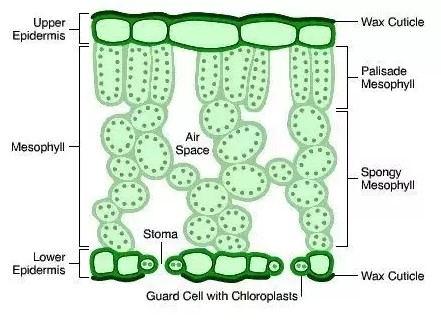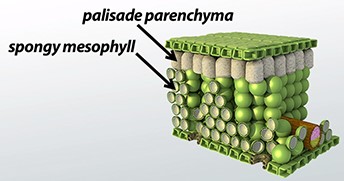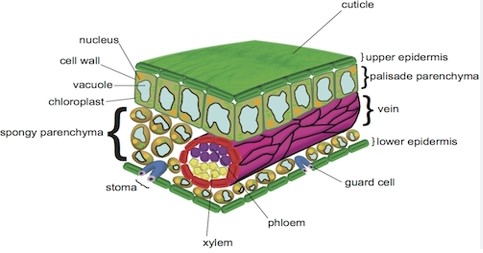Plant cells are specialized in many unique ways, contributing to the diverse structures and functions within a plant. Among these cells, the palisade and spongy parenchyma play crucial roles in photosynthesis and respiration. Both types of parenchyma cells are located in the leaves but differ significantly in structure and function.
Palisade parenchyma cells are elongated and packed tightly together, primarily facilitating intense photosynthesis due to their high chloroplast count. In contrast, spongy parenchyma cells are more irregularly shaped and loosely packed, allowing for efficient gas exchange between the plant and its environment. This distinct arrangement enhances a plant’s ability to convert light energy into chemical energy and exchange gases necessary for respiration.
While palisade parenchyma focuses on capturing light and performing photosynthesis, spongy parenchyma optimizes the exchange of gases such as oxygen and carbon dioxide. These functionalities are critical in supporting the plant’s overall health and growth, demonstrating the intricate design of plant tissues to optimize survival and efficiency.

Palisade Parenchyma
Location and Structure
Palisade parenchyma cells form a distinct layer in the leaf of many plants, particularly those found in environments where light is abundant. These cells are typically located directly beneath the epidermis and above the spongy parenchyma. Structurally, they are elongated, column-like cells that are tightly packed to minimize spaces between them. This arrangement allows for maximum light absorption due to the large surface area exposed to the sun. The cells are also rich in chloroplasts, which are critical for photosynthesis.
Primary Functions
The primary function of palisade parenchyma is to facilitate efficient photosynthesis. The high concentration of chloroplasts in these cells enables them to capture a significant amount of light energy, which is necessary for converting carbon dioxide and water into glucose and oxygen. Additionally, the close packing of these cells helps to increase the leaf’s mechanical strength, which is vital for maintaining its structure and position for optimal light exposure.
Role in Photosynthesis
During photosynthesis, palisade parenchyma cells play a crucial role in light absorption. They contain numerous chloroplasts, which are the sites of the light-dependent reactions of photosynthesis. These reactions involve the conversion of light energy into chemical energy stored in ATP and NADPH, which are then used in the Calvin cycle to produce sugars. The efficiency of these cells in capturing sunlight directly impacts the rate of photosynthesis and, consequently, the overall growth and health of the plant.
Spongy Parenchyma
Location and Structure
Spongy parenchyma is found beneath the palisade parenchyma and is integral to the lower part of the leaf. This tissue is characterized by its loose, irregular arrangement of cells, which creates large intercellular spaces. These spaces are essential for facilitating gas exchange within the leaf. The cells, while fewer in chloroplasts compared to palisade parenchyma, are crucial for the plant’s respiratory needs and additional photosynthetic processes.
Primary Functions
The primary role of spongy parenchyma is to aid in gas exchange. The large air spaces between the cells allow for the efficient movement of carbon dioxide, oxygen, and water vapor. This feature is particularly important for the exchange of gases that occurs during photosynthesis and respiration. Moreover, spongy parenchyma helps in regulating leaf temperature and water balance through the process of transpiration.
Contribution to Gas Exchange
The design of spongy parenchyma maximizes its surface area, enhancing its ability to manage gases crucial for the plant’s metabolism. Oxygen produced during photosynthesis in the palisade cells diffuses down to the spongy parenchyma and exits the leaf through the stomata, while carbon dioxide from the atmosphere enters in the reverse direction. This efficient gas exchange is vital for maintaining the photosynthetic rate and the plant’s overall health.
Key Differences
Cellular Arrangement
One of the most notable differences between palisade and spongy parenchyma is their cellular arrangement. Palisade parenchyma cells are tightly packed with little intercellular space and aligned in columns, maximizing light absorption. In contrast, spongy parenchyma features a more random and loose cellular arrangement. This structure is optimized for gas exchange rather than light capture.
Photosynthetic Efficiency
While both palisade and spongy parenchyma contribute to photosynthesis, their efficiencies differ. Palisade parenchyma, with its high density of chloroplasts and orientation towards the light, is more efficient at converting sunlight into energy. Spongy parenchyma, while still photosynthetically active, plays a more significant role in the exchange of gases necessary for the Calvin cycle to proceed within the chloroplasts.
Interaction with Light
The interaction with light also differs between the two types of parenchyma. Palisade parenchyma is designed to absorb maximum light, directly impacting the plant’s ability to grow and thrive. Spongy parenchyma, however, allows light to pass through more easily, ensuring that lower layers of the leaf, including itself, are also able to engage in photosynthesis, albeit to a lesser extent compared to the upper palisade layer.

Similarities
Tissue Composition
Both palisade and spongy parenchyma are comprised of parenchyma cells, which are fundamental to plant tissue. These cells are relatively unspecialized and flexible in their function, but they adapt specifically within each type of parenchyma to meet different physiological demands. Each has a cell wall, cytoplasm, and large vacuoles, which are crucial for maintaining cell turgidity and storage of substances.
Role in Plant Physiology
Despite their differences, both types of parenchyma play critical roles in plant physiology, contributing to the photosynthesis process. Palisade parenchyma captures
light effectively, while spongy parenchyma facilitates the exchange of gases necessary for the synthesis of organic compounds. Together, these layers work synchronously to optimize energy production and respiration within the plant, ensuring efficient conversion of solar energy into chemical energy.
Impact on Plant Health
Importance in Plant Survival
The health of palisade and spongy parenchyma directly influences plant survival. These tissues are crucial for the production of glucose, which is a primary energy source for plants and vital for their growth and reproduction. Effective photosynthesis by these tissues ensures a steady supply of glucose, which helps plants to withstand environmental stresses and grow successfully.
Influence on Overall Health
Healthy palisade and spongy parenchyma cells impact the plant’s overall health by promoting vigorous growth and increasing resistance to diseases. When these tissues are functioning optimally, they enhance the plant’s ability to absorb sunlight and exchange gases, which results in stronger, more resilient plants capable of better competing for resources and surviving in diverse environments.
Scientific Studies
Research on Parenchyma Cells
Recent scientific research has focused extensively on understanding the unique properties and capabilities of parenchyma cells. Studies often examine how these cells respond to different light conditions, water availability, and atmospheric changes. The insights gained from this research contribute significantly to our understanding of plant adaptability and resilience.
Findings from Recent Studies
Recent studies have shown that modifications in the structure of palisade and spongy parenchyma can lead plants to better adapt to their changing environments. For instance, in areas with high light intensity, plants might develop thicker layers of palisade parenchyma to maximize photosynthesis. Conversely, in shady environments, spongy parenchyma may become more pronounced to facilitate greater gas exchange in reduced light conditions.
Practical Applications
Agriculture and Gardening
Understanding the functions and importance of palisade and spongy parenchyma has practical applications in agriculture and gardening. Farmers and gardeners can manipulate plant environments to optimize these tissues for better growth. For example, adjusting shading systems to control light exposure can enhance the efficiency of these parenchymal layers, leading to healthier, more productive crops.
Biotechnological Innovations
Biotechnological advancements have leveraged knowledge of parenchyma cell functions to develop crops that are more efficient at photosynthesis and have greater resilience to climatic stress. Genetic engineering efforts focus on enhancing the properties of these tissues, such as increasing the chloroplast density in palisade cells or enhancing the intercellular spacing in spongy parenchyma to boost gas exchange capabilities.
These developments not only contribute to better yield and crop quality but also offer solutions to challenges posed by global climate change. As we continue to study and understand these critical components of plant anatomy, the potential to innovate and improve plant cultivation methods grows, demonstrating the interconnectedness of botanical science and agricultural production.
Frequently Asked Questions
What is Palisade Parenchyma?
Palisade parenchyma refers to a layer of cells found in the plant leaves, known for their cylindrical and tightly packed structure. These cells are rich in chloroplasts, making them the primary site for photosynthesis, where they convert light energy into chemical energy.
What is Spongy Parenchyma?
Spongy parenchyma, also located in the leaves, consists of loosely arranged cells with ample spaces between them. This structure facilitates efficient gas exchange by providing a large surface area for gases like carbon dioxide and oxygen to diffuse in and out of the cells.
How do Palisade and Spongy Parenchyma differ?
The main difference between palisade and spongy parenchyma lies in their structure and function. Palisade parenchyma cells are elongated and tightly packed to maximize light absorption, whereas spongy parenchyma cells are more irregular and spaced apart to enhance gas exchange.
Why are Palisade and Spongy Parenchyma important in photosynthesis?
Both types of parenchyma cells are essential for photosynthesis but in different ways. Palisade parenchyma absorbs maximum light for the photosynthesis process, while spongy parenchyma aids in exchanging the gases required for synthesizing food.
Conclusion
The specialized structures of palisade and spongy parenchyma demonstrate the complexity and efficiency of plant tissues. Their distinct roles not only underline the adaptability of plants to their environments but also highlight the evolutionary advancements in plant biology that optimize both energy production and resource exchange.
In understanding the differences and functions of these parenchyma cells, we gain insights into the fundamental operations of plant life, reflecting the intricate relationships between structure, function, and survival in the natural world.

